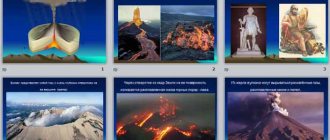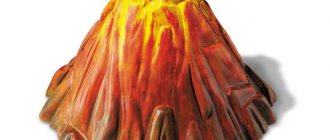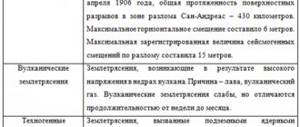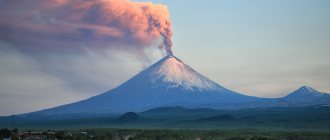Why do volcanoes erupt?
Apparently, the story should begin with magma. Very often it forms in places where ocean water penetrates the Earth's mantle and lowers the melting point in one layer or another. Thanks to the delicate balance of three geological factors, hot rocks tend to remain below the surface. The first is lithostatic pressure - this is the weight of the crust pressing on the magma from above. Magmastatic pressure acts on it from below. The opposition of these forces is restrained by a third factor - the strength of rocks. They are usually monolithic and heavy enough to contain magma. However, when the balance is upset, the consequences can be catastrophic.
One of the most common causes of volcanic eruptions is an increase in magmastatic pressure. Magma contains many different elements and compounds. However, some of them, for example, water and sulfur, at a certain concentration cease to dissolve in it, forming gas bubbles under high pressure. Once they reach the surface, they literally explode. And when it happens to millions at once, the energy released can be enough to propel ash from the eruption into the stratosphere. But before they burst, the bubbles behave like carbon dioxide in mineral water. They reduce the density of magma and increase the force of its pushing through the earth's crust. Many geologists believe that it was this process that triggered the Paricutin eruption.
There are two known natural causes for the formation of these bubbles. Sometimes new magma coming from greater depths brings compounds that are in a gaseous state into the molten rocks. However, they can also be generated as a result of cooling of magma. The latter is a mixture of gases and molten minerals. As it cools, this substance crystallizes. The resulting rocks are not expected to contain large amounts of gases, so they are squeezed upward in the form of those very “detonating” bubbles.
Volcano Paricutin
However, not all eruptions occur due to increased magmastatic pressure. Sometimes this occurs due to a decrease in the force acting on the opposite side. In particular, as a result of landslides, which carry away huge amounts of rock, creating pressure on the magma chamber. Such “unloading” is responsible for many eruptions, including very famous ones, such as the explosion of Mount St. Helens in 1980. A decrease in lithostatic pressure can also occur over long periods of time. Many geologists are seriously concerned about the possibility that landslides and melting glaciers as a result of climate warming will trigger increased volcanic activity.
Finally, eruptions can occur when the rocks holding magma lose their strength. The corrosive gases and heat released by the molten rocks corrode them, causing even hard stones to turn into soft clay. Rocks are also weakened by tectonic processes. As a result of earthquakes, cracks sometimes appear in the earth's surface, which serve as outlets for magma. In addition, as a result of the displacement of continental plates, the earth's crust can become dangerously thin.
Unfortunately, understanding the processes leading to volcanic eruptions does not make it easier to predict the latter. Scientists have learned to relatively accurately determine the strength and weight of the earth's crust in one area or another of the planet, but it is still almost impossible to track how high the pressure is in magma chambers due to the depth at which they are located. However, scientists are constantly inventing and improving technologies for predicting volcanic activity. Advances in thermal imaging make it possible to detect hot spots beneath the planet's surface, and spectrometers make it possible to analyze the gas composition of magma. Lasers, in turn, can track the effect of rising magma on the shape of a volcano. Hopefully, over time, these and other tools will be able to predict where and when the next eruption should occur. This will save many human lives.
What is a volcano?
Externally, the volcano resembles a mountain. There is a geological fault inside it. In science, a volcano is a formation of geological rock located on the surface of the earth. Magma, which is very hot, erupts through it. It is magma that subsequently forms volcanic gases and rocks, as well as lava. Most of the volcanoes on earth were formed several centuries ago. Today, new volcanoes rarely appear on the planet. But this happens much less frequently than before.
Responsibilities
The task of a modern volcanologist is to study volcanoes in order to predict their eruptions. This is necessary not only for the timely evacuation of the population, but also for the use of volcanic heat in the future.
Seismic stations monitor volcanoes around the clock, recording the slightest changes as harbingers of an upcoming eruption. The consequences of the eruptions are also being carefully studied. The data can be used to describe the formation of a planet over billions of years, and traces of lava can unlock the secrets of mineral deposits.
Directly during a volcanic eruption, volcanologists monitor the direction of the heat plume. The data obtained is of great importance for weather stations and airlines.
Where do they teach
Volcanologists in Russia are specialists. In Moscow, the profession of volcanologist can be obtained at the Geological Faculty of Moscow State University. Lomonosov and St. Petersburg State University, Department of Petrology and Volcanology - these are the main centers for the study of volcanoes in Russia. And also at the Department of Geomorphology and Paleogeography of the Faculty of Geography and at the Department of Mechanics of the Faculty of Mechanics and Mathematics.
Schoolchildren interested in volcanoes will be interested in classes at the Geological School of Moscow State University, where free classes are held 2 times a week, as well as in the open lecture hall of the Faculty of Geology of Moscow State University.
In other cities, the specialization of a volcanologist can be obtained at the geological exploration faculties of universities or technical universities. Most often, geologists and geophysicists become volcanologists.
Pros and cons of the profession
Pros:
Despite the rarity of the profession, volcanologists are constantly in demand and are in demand: more than 1,000 active volcanoes have been registered on earth. As MSU volcanologist professor P. Plechov noted: “A billion years of volcanic activity on earth is guaranteed.”
International cooperation is well developed in this industry. Volcanologists around the world are working together to study volcanoes and improve research methods and technologies. There is constant communication and exchange of experience between volcanologists from all over the world at World Volcanological Meetings.
In recent decades, work on grants has become possible even among young volcanologists.
As a rule, volcanoes are named after the volcanologists who studied them - Ivanova Volcano, Kosheleva Volcano, Popkova Volcano, Averyevsky Geyser. There is a real opportunity to immortalize your name in the name of the next volcano or geyser!
Minuses:
High degree of risk: the study of active volcanoes takes place in conditions of increased danger - surrounded by hot lava, suffocating gases and hot dust, constantly exposed to the danger of eruption. For protection, volcanologists use special clothing—heat-insulating clothing and shoes coated with a layer of aluminum or other metal that reflects heat. Protective helmets are put on the head. Gas masks and gas masks are designed to protect against poisonous gases.
Reviews about the profession
“There is still romance in the work of a volcanologist. We are almost always “in the fields”. In Klyuchi we have no restaurants, no theaters, nothing... so we have to work constantly. In general, there are two periods in the work of a volcanologist: office and field. It is in the office that the scientist processes field information for the past season, selects lava samples, and plans work for the next field season. And in the summer he goes to the volcano, takes samples, takes measurements, calculates the volume of rocks erupted, etc.”
Yuri Demyanchuk,
head of the Kamchatka volcano station.
How are volcanoes formed?
If we briefly explain the essence of the formation of a volcano, it will look like this. Under the earth's crust there is a special layer under strong pressure, consisting of molten rocks, it is called magma. If cracks suddenly begin to appear in the earth’s crust, then hills form on the surface of the earth. Through them, magma comes out under strong pressure. At the surface of the earth, it begins to break down into hot lava, which then solidifies, causing the volcanic mountain to become larger and larger. The emerging volcano becomes such a vulnerable spot on the surface that it spews volcanic gases onto the surface with great frequency.
What is a volcano made of?
In order to understand how magma erupts, you need to know what a volcano is made of. Its main components are: a volcanic chamber, a vent and craters. What is a volcanic source? This is the place where magma is formed. But not everyone knows what a volcano’s crater and crater are? A vent is a special channel that connects the hearth with the surface of the earth. A crater is a small bowl-shaped depression on the surface of a volcano. Its size can reach several kilometers.
What is a volcanic eruption
Volcanoes are the “natural valves” of the Earth.
To understand in general terms how and why they erupt, it is enough to imagine the process of “degassing” a bottle of carbonated drink. If you carefully open a bottle of lemonade or champagne, there will be a popping sound and smoke and sometimes foam will appear from the bottle. But we all know what happens if the bottle is shaken or heated before opening. So, by analogy, a volcanic eruption occurs due to the degassing of magma (magma is liquid rock underground). In the place where the earth's crust is "loosely closed", magma can escape from the bowels of the Earth. Rising upward, magma loses gases and water vapor and turns into lava - magma depleted in gases.
An eruption can last for varying amounts of time—several hours or many years. Volcanic eruptions are classified as geological emergencies.
There are 5 main types of eruptions. The names for them are usually “selected” in honor of famous volcanoes.
The volcanic type is named after the island of Vulcano off the coast of Sicily; sometimes it is also called Plinian - after the Roman scientist Pliny, who died during the eruption of Vesuvius in 79 AD. e. By the way, Vesuvius is a typical representative of this type of volcano; it is also the only active volcano on mainland Europe. This type of eruption is characterized by the occurrence of strong and sudden explosions following a long period of peace; explosions are accompanied by the release of huge amounts of ash and ash flows. Such an eruption was described by Homer, Thucydides, Aristotle and other ancient authors. Volcanic (Plinian) eruptions are dangerous because they occur suddenly, often without prior warning events.
Article on the topic
Life on a volcano. The most famous cases of rampage by fire-breathing giants
The Peleian type was named after the Pele volcano on the island of Martinique in the Caribbean. It is characterized by the manifestation of powerful directed explosions after a long period of dormancy, which is why the volcano is considered extinct, and therefore doubly dangerous. The Peleian eruption is characterized by the formation of enormous red-hot avalanches and scorching clouds. By the way, in 1956, a similar eruption occurred in Kamchatka, then the explosion destroyed the top of the Bezymianny volcano, a cloud of ash rose, and red-hot avalanches descended along the slopes of the volcano.
The Hawaiian type of eruption is named after the volcanic activity on the Hawaiian chain - the volcanoes Mauna Kea, Mauna Loa, Kilauea, Hualalai and Kohala in the Pacific Ocean. The main feature of this type of volcanoes is the free flowing and outpouring of liquid basaltic lava, as well as the formation of lava lakes; eruptions are rare, separated by periods of hundreds of years.
The Icelandic type of eruptions is generally similar to the Hawaiian type. Iceland itself is a country of volcanoes; modern volcanoes are located here in a chain in the southeastern part of the island. An Icelandic-type eruption is characterized by ejections of very liquid basaltic lava and occurs along fissures. The craters are filled with lava, which then spreads out in numerous streams.
The Strombolian type is named after the island (and volcano) Stromboli in the Mediterranean Sea - it rises 3500 m above the seabed and is the highest volcano in Europe. Since ancient times, this volcano with its fiery peak has been known as the Lighthouse of the Mediterranean; it was described by Aristotle. The Strombolian type of eruption is characterized by rhythmic explosions - the volcano regularly throws a “charge” of bombs and pieces of hot slag into the air. The amount of ash is insignificant, and due to the fact that the liquid lava in the crater is in contact with the atmosphere, the emissions become “luminous”.
Experts qualified the type of Tolbachik eruption in November 2012 as “Strombolian,” Rossiyskaya Gazeta reports.
Features of the profession
Modern volcanology is designed to study volcanoes not only with the aim of predicting their eruptions, but also using the energy of volcanic heat for the needs of the national economy.
Monitoring of active volcanoes is carried out around the clock by seismic stations, which record volcanic earthquakes - harbingers of future eruptions. The structures of ancient extinct volcanoes are studied for scientific and practical purposes. These studies provide insight into the conditions on our planet during its formation billions of years ago. Studying traces of the movement of molten lava from the crater of a volcano into the earth's crust allows us to understand the principle of the formation of mineral deposits - copper, iron, zinc.
The help of volcanologists is invaluable at the time of a volcanic eruption: by monitoring the direction of the ash plume, studying its chemical composition, they issue forecasts to weather services and air traffic controllers who correct aircraft flight trajectories. This ensures the safety of flights of local, Russian and international airlines.
Volcanologists also study geysers - gushing sources of hot water, which are geographically located, as a rule, near volcanoes.








